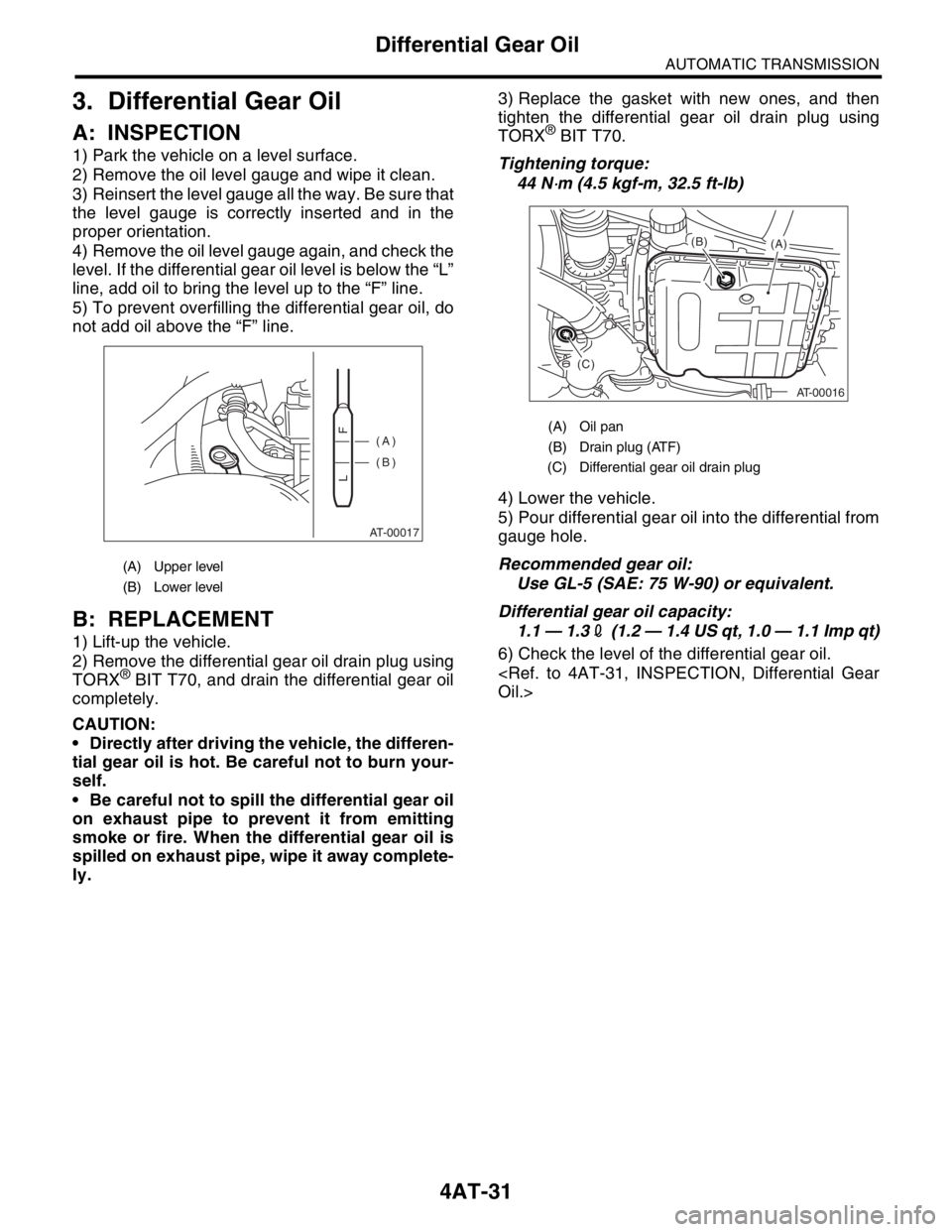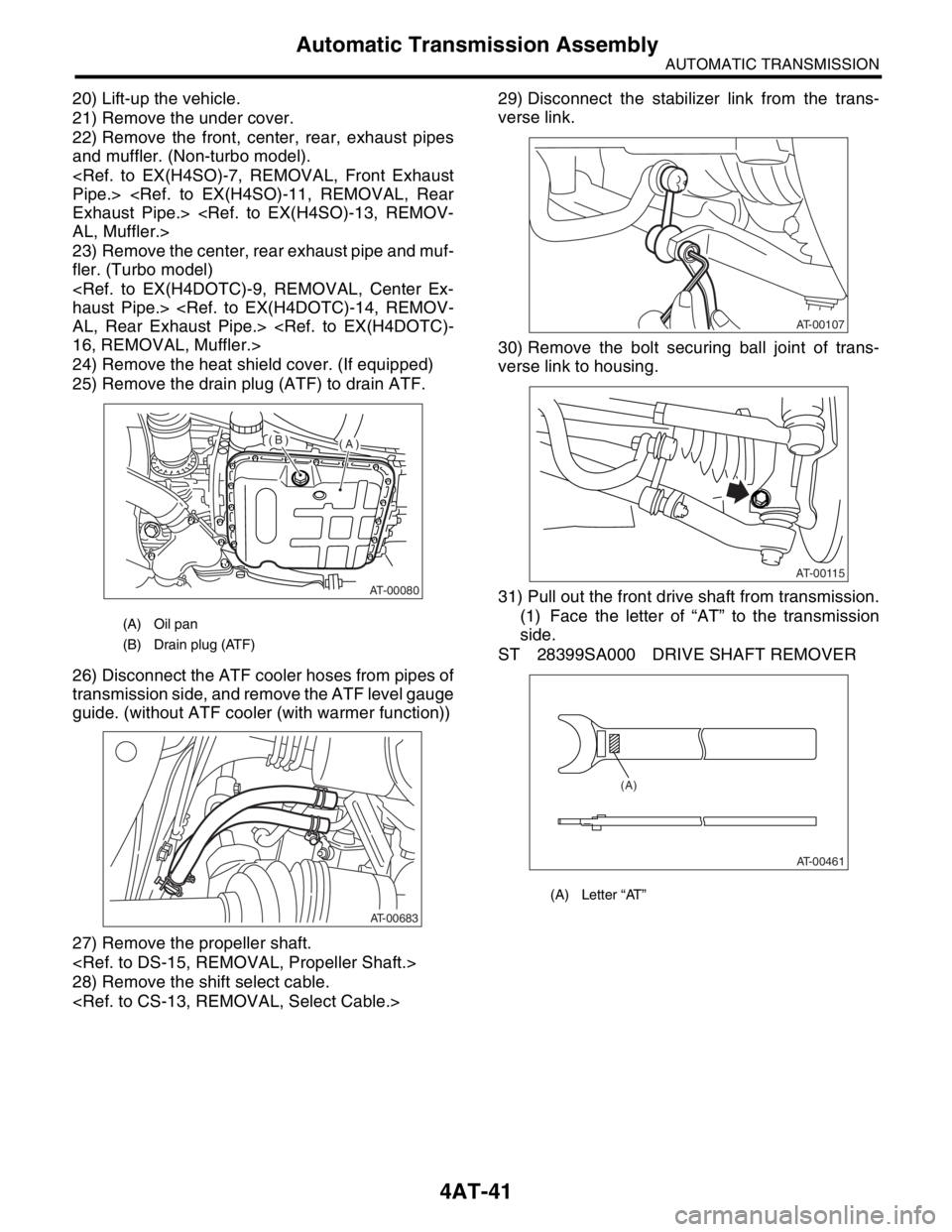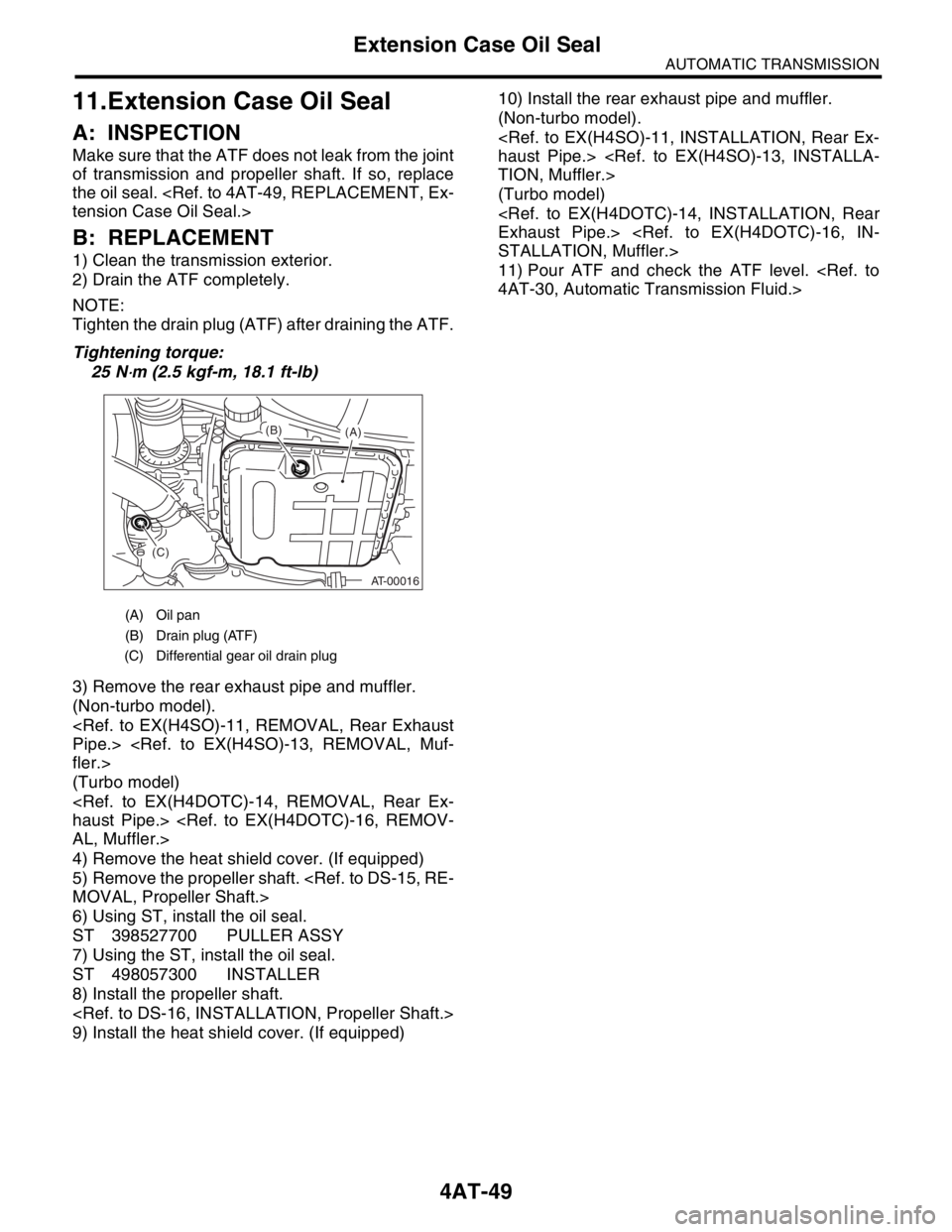2004 SUBARU FORESTER oil level
[x] Cancel search: oil levelPage 2320 of 2870

4AT-8
AUTOMATIC TRANSMISSION
General Description
(1) ATF level gauge (19) Oil filter (41) Transmission case
(2) ATF charger pipe (20) Oil filter stud bolt (42) Plate ASSY
(3) O-ring (21) Drain plug (ATF) (43) Washer
(4) Transfer valve plate (22) Gasket (44) Bushing (turbo model)
(Non-turbo model) (23) Oil pan (45) ATF cooler inlet pipe (model with
ATF cooler (with warmer func-
tion)) (5) Transfer valve ASSY (24) Magnet
(Non-turbo model) (25) Stud bolt (Short)
(6) Transfer clutch seal
(Non-turbo model)(26) Stud bolt (Long) (46) ATF cooler outlet pipe (model
with ATF cooler (with warmer
function)) (27) Parking rod
(7) Transfer duty solenoid (non-turbo
model)(28) Manual plate
(29) Spring pin
(8) Straight pin (30) Detention springTightening torque: N
⋅m (kgf-m, ft-lb)
(9) Return spring (31) BallT1: 3.4 (0.35, 2.6)
(10) Shaft (32) SpringT2: 5 (0.5, 3.6)
(11) Parking pawl (33) GasketT3: 6 (0.6, 4.4)
(12) Parking support (34) ATF cooler outlet pipe (model
without ATF cooler (with warmer
function))T4: 8 (0.8, 6)
(13) Inlet filter (Non-turbo model)T5: 12 (1.2, 8.7)
(14) GasketT6: 13 (1.3, 10)
(15) ATF cooler inlet pipe (model with-
out ATF cooler (with warmer func-
tion))(35) Union screwT7: 14 (1.4, 10)
(36) Oil sealT8: 18 (1.8, 13)
(37) Range select leverT9: 25 (2.5, 18.1)
(16) Union screw (38) Inhibitor switch ASSYT10: 45 (4.6, 33.2)
(17) O-ring (39) NippleT11: 21 (2.1, 15.5)
(18) Test plug (40) Air breather hose
Page 2342 of 2870

4AT-30
AUTOMATIC TRANSMISSION
Automatic Transmission Fluid
2. Automatic Transmission Flu-
id
A: INSPECTION
NOTE:
The level of ATF varies with fluid temperature. Pay
attention to the ATF temperature when checking
ATF level.
1) Raise the ATF temperature by driving a distance
of 5 to 10 km (3 to 6 miles). Otherwise, idle the en-
gine to raise ATF temperature to 70 — 80°C (158
— 176°F) on Subaru Select Monitor.
TION, Subaru Select Monitor.>
2) Make sure the vehicle is level.
3) After selecting all positions (P, R, N, D, 3, 2, 1),
set the select lever in “P” range. Measure the ATF
level with engine idling for one or two minutes.
4) Make sure that ATF level is above the center of
upper level and lower level at HOT side.
If the ATF level is below the lower level, check for
leaks in the transmission. If there are leaks, it is
necessary to repair or replace gasket, oil seals,
plugs or other parts.
5) If the ATF level is below the center between up-
per level and lower level, add the recommended
ATF until the fluid level is found above the center
between upper level and lower level marks.
CAUTION:
Use care not to exceed the upper level.
Remember that the addition of ATF to the up-
per limit mark when the transmission is cold
will overfilling of ATF, causing a transmission
failure.
6) Check ATF level after raising ATF temperature
to 70 — 80°C (158 — 176°F) by running the vehicle
or by idling the engine again.
B: REPLACEMENT
1) Lift-up the vehicle.2) Drain the ATF completely.
CAUTION:
Directly after the engine has been running, the
ATF is hot. Be careful not to burn yourself.
3) Replace the gasket with new one, and then tight-
en the drain plug (ATF).
Tightening torque:
25 N
⋅m (2.5 kgf-m, 18.1 ft-lb)
4) Lower the vehicle.
5) Pour ATF from the ATF charge pipe.
Recommended fluid:
DEXRON III type automatic transmission flu-
id
Capacity:
Fill the same amount of ATF drained from
drain plug hole.
CAPACITY WHEN TRANSMISSION IS OVER-
HAULED:
2.0 L NON-TURBO MODEL
8.4 — 8.72 (8.9 — 9.2 US qt, 7.4 — 7.7 Imp
qt)
EXCEPT 2.0 L NON-TURBO MODEL
9.3 — 9.62 (9.8 — 10.1 US qt, 8.2 — 8.4 Imp
qt)
6) Check the level and leaks of ATF.
(A) ATF level gauge
(B) Upper level
(C) Lower level
AT-00674
COLD
LFHOT LF
(C)
(C)
(B)
(B)
(A)(A) Oil pan
(B) Drain plug (ATF)
(C) Differential gear oil drain plug
AT-00016
(A) (B)
(C)
Page 2343 of 2870

4AT-31
AUTOMATIC TRANSMISSION
Differential Gear Oil
3. Differential Gear Oil
A: INSPECTION
1) Park the vehicle on a level surface.
2) Remove the oil level gauge and wipe it clean.
3) Reinsert the level gauge all the way. Be sure that
the level gauge is correctly inserted and in the
proper orientation.
4) Remove the oil level gauge again, and check the
level. If the differential gear oil level is below the “L”
line, add oil to bring the level up to the “F” line.
5) To prevent overfilling the differential gear oil, do
not add oil above the “F” line.
B: REPLACEMENT
1) Lift-up the vehicle.
2) Remove the differential gear oil drain plug using
TORX
® BIT T70, and drain the differential gear oil
completely.
CAUTION:
Directly after driving the vehicle, the differen-
tial gear oil is hot. Be careful not to burn your-
self.
Be careful not to spill the differential gear oil
on exhaust pipe to prevent it from emitting
smoke or fire. When the differential gear oil is
spilled on exhaust pipe, wipe it away complete-
ly.3) Replace the gasket with new ones, and then
tighten the differential gear oil drain plug using
TORX
® BIT T70.
Tightening torque:
44 N
⋅m (4.5 kgf-m, 32.5 ft-lb)
4) Lower the vehicle.
5) Pour differential gear oil into the differential from
gauge hole.
Recommended gear oil:
Use GL-5 (SAE: 75 W-90) or equivalent.
Differential gear oil capacity:
1.1 — 1.32 (1.2 — 1.4 US qt, 1.0 — 1.1 Imp qt)
6) Check the level of the differential gear oil.
(A) Upper level
(B) Lower level
AT-00017
(A)
(B)
LF
(A) Oil pan
(B) Drain plug (ATF)
(C) Differential gear oil drain plug
AT-00016
(A) (B)
(C)
Page 2344 of 2870

4AT-32
AUTOMATIC TRANSMISSION
Road Test
4. Road Test
A: INSPECTION
1. GENERAL PRECAUTION
Road tests should be conducted to properly diag-
nose the condition of the automatic transmission.
NOTE:
When performing the test, do not exceed posted
speed limit.
2. D RANGE SHIFT FUNCTION
Check shifting between 1st ←→ 2nd ←→ 3rd ←→
4th while driving on normal city streets.
3. D RANGE SHIFT SHOCK
Check the shock level when shifting up during nor-
mal driving.
4. KICK-DOWN FUNCTION
Check kick-down for each gear. Also check the
kick-down shock level.
5. ENGINE BRAKE OPERATION
Check the 3rd gear engine brake when shifting
down from D ←→ 3rd range while driving in 4th
gear of D range [50 — 60 km/h (31 — 37 MPH)].
Check the 2nd gear engine brake when shifting
between 3rd ←→ 2nd range while driving in the 3rd
range of 3rd gear [40 — 50 km/h (25 — 31 MPH)].
Check the 1st gear engine brake when shifting
between 2nd ←→ 1st range while driving in the 2nd
range of 2nd gear [20 — 30 km/h (12 — 19 MPH)].
6. LOCK-UP FUNCTION
Check that rpm does not change sharply when
the axle pedal is lightly depressed when driving on
flat roads at 60 km/h (37 MPH).
Check slip lock-up with following procedure.
Subaru Select Monitor is needed for checking (EC,
EK model).
Before start checking, check that the DTC is not ex-
isted using Subaru Select Monitor. When the DTC
is existed, perform the collective action with DTC
and check that the DTC is not existed again, and
then start the checking.
1) The check performed on flat and straight road or
free roller.
NOTE:
Slip lock-up does not operate when the vehicle is
lifted up, because of not occurring surface resis-
tance.
Also checking on the free roller, check with de-
pressing foot brake lightly to make the checking
easier, because the surface resistance will be defi-
cient2) Connect the Subaru Select Monitor.
3) Check ATF temperature using Subaru Select
Monitor.
NOTE:
ATF temperature is between 50 — 100°C (122
— 212°F).
When the temperature is low, warm-up the ATF
by running the vehicle or etc.
4) Start the engine, and make the lock-up duty be
able to read on data display of Subaru Select Mon-
itor.
5) 35 — 40 Drive the vehicle at a constant speed of
35 — 40 km/h (22 — 25 MPH).
6) Read the lock-up duty while vehicle is running.
Standard value:
25 — 45%
NOTE:
On the free roller, the value sometimes lowers.
Slip lock-up control is not operating when the
lock-up duty is less than 5%, or when the lock-up
duty goes down immediately after starts rise. On
these cases, improper ATF or deterioration of ATF
may be the cause. Check the amount of ATF or re-
place them, and then recheck it.
7. P RANGE OPERATION
Stop the vehicle on an uphill grade of 5% or more
and shift to “P” range. Check that the vehicle does
not move when the parking brake is released.
8. NOISE AND VIBRATION
Check for unusual sounds and vibration while driv-
ing and during shifting.
9. CLIMBING CONTROL FUNCTION
Check that the gear remains in 3rd when going
up a grade.
Check that the gear remains in 3rd when apply-
ing the brakes while going down a grade.
10.TRANSFER CLUTCH
Check tight corner braking when the vehicle started
with steering fully turned.
11.OIL LEAKS
After the driving test, inspect for oil leaks.
Page 2345 of 2870

4AT-33
AUTOMATIC TRANSMISSION
Stall Test
5. Stall Test
A: INSPECTION
NOTE:
The stall test is of extreme importance in diagnos-
ing the condition of the automatic transmission and
the engine. It should be conducted to measure the
engine stall speeds in “R” and “2” ranges (when
HOLD switch is ON).
Purposes of the stall test:
To check the operation of the automatic trans-
mission clutch.
To check the operation of the torque converter
clutch.
To check engine performance.
1) Check that the throttle valve opens fully.
2) Check that the engine oil level is correct.
3) Check that the coolant level is correct.
4) Check that the ATF level is correct.
5) Check that the differential gear oil level is cor-
rect.
6) Increase ATF temperature to 70 — 80°C (158 —
176°F) by idling the engine for approximately 30
minutes (with select lever set to “N” or “P”).
7) Place the wheel chocks at the front and rear of
all wheels and engage the parking brake.
8) Shift the manual linkage to ensure it operates
properly, then shift the select lever to the “2” range
and turn the HOLD switch to ON.
9) While forcibly depressing the foot brake pedal,
gradually depress the accelerator pedal until the
engine operates at full throttle.
10) When the engine speed is stabilized, record
that speed quickly and release the accelerator ped-
al.
11) Shift the select lever to “N” range, and cool
down the engine by idling it for more than one
minute.12) If the stall speed in “2” range (with HOLD switch
ON) is higher than specifications, low clutch slip-
ping and “2-4 brake slipping” may occur. To identify
it, conduct the same test as above in “R” range.
13) Perform the stall tests with the select lever in
the “D” range.
NOTE:
Do not continue the stall test for more than five
seconds at a time (from closed throttle, fully open
throttle to stall speed reading). Failure to follow this
instruction causes the engine oil and ATF to deteri-
orate and the clutch and brake to be adversely af-
fected.
Be sure to cool down the engine for at least one
minute after each stall test with the select lever set
in the “P” or “N” range and with the idle speed lower
than 1,200 rpm.
If the stall speed is higher than the specified
range, attempt to finish the stall test in as short a
time as possible, in order to prevent the automatic
transmission from sustaining damage.
Stall speed (at sea level):
2.0 L NON-TURBO MODEL
2,000 — 2,500 rpm
2.0 L TURBO MODEL
2,600 — 3,300 rpm
2.5 L NON-TURBO MODEL
2,100 — 2,600 rpm
2.5 L TURBO MODEL
2,700 — 3,200 rpm
(A) Brake pedal
(B) Accelerator pedal
(A) (B)
P
R
N
D
3
2
1
AT-00449
Page 2353 of 2870

4AT-41
AUTOMATIC TRANSMISSION
Automatic Transmission Assembly
20) Lift-up the vehicle.
21) Remove the under cover.
22) Remove the front, center, rear, exhaust pipes
and muffler. (Non-turbo model).
23) Remove the center, rear exhaust pipe and muf-
fler. (Turbo model)
24) Remove the heat shield cover. (If equipped)
25) Remove the drain plug (ATF) to drain ATF.
26) Disconnect the ATF cooler hoses from pipes of
transmission side, and remove the ATF level gauge
guide. (without ATF cooler (with warmer function))
27) Remove the propeller shaft.
28) Remove the shift select cable.
verse link.
30) Remove the bolt securing ball joint of trans-
verse link to housing.
31) Pull out the front drive shaft from transmission.
(1) Face the letter of “AT” to the transmission
side.
ST 28399SA000 DRIVE SHAFT REMOVER
(A) Oil pan
(B) Drain plug (ATF)
AT-00080
(A)(B)
AT-00683
(A) Letter “AT”
AT-00107
AT-00115
AT-00461
(A)
Page 2358 of 2870

4AT-46
AUTOMATIC TRANSMISSION
Automatic Transmission Assembly
33) Connect the ATF cooler hoses to pipes on
transmission side, and then install the oil charge
pipe. (with ATF cooler (with warmer function))
34) Install the ATF level gauge guide.
35) Connect the following connectors.
(1) Transmission harness connectors
(2) Transmission ground terminal
36) Install the harness to bracket.
37) Install the air cleaner case stay. (Non-turbo
model)
Tightening torque:
16 N
⋅m (1.6 kgf-m, 11.6 ft-lb)38) Install the air cleaner case and air intake duct.
(Non-turbo model).
39) Install the intercooler. (Turbo model)
40) Connect the battery ground cable to battery.
41) Pour ATF from the oil charge pipe.
42) Check the ATF level.
43) Take off the vehicle from a lift.
44) Check the select lever operation.
45) Execute the learning control promotion. (Turbo
model)
Select Monitor.>
46) Perform the road test.
(A) Inlet hose
(B) Outlet hose
AT-01866(A)(B)
AT-00693
AT-01867
Page 2362 of 2870

4AT-49
AUTOMATIC TRANSMISSION
Extension Case Oil Seal
11.Extension Case Oil Seal
A: INSPECTION
Make sure that the ATF does not leak from the joint
of transmission and propeller shaft. If so, replace
the oil seal.
B: REPLACEMENT
1) Clean the transmission exterior.
2) Drain the ATF completely.
NOTE:
Tighten the drain plug (ATF) after draining the ATF.
Tightening torque:
25 N
⋅m (2.5 kgf-m, 18.1 ft-lb)
3) Remove the rear exhaust pipe and muffler.
(Non-turbo model).
(Turbo model)
4) Remove the heat shield cover. (If equipped)
5) Remove the propeller shaft.
6) Using ST, install the oil seal.
ST 398527700 PULLER ASSY
7) Using the ST, install the oil seal.
ST 498057300 INSTALLER
8) Install the propeller shaft.
9) Install the heat shield cover. (If equipped)10) Install the rear exhaust pipe and muffler.
(Non-turbo model).
(Turbo model)
11) Pour ATF and check the ATF level.
(A) Oil pan
(B) Drain plug (ATF)
(C) Differential gear oil drain plug
AT-00016
(A) (B)
(C)